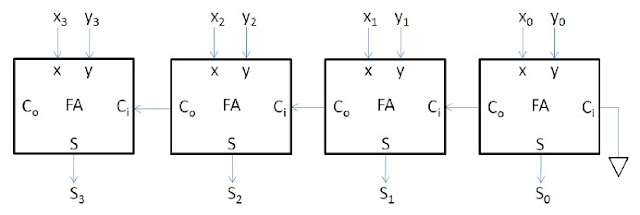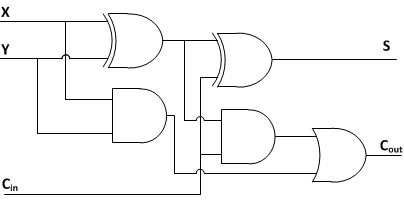Ripple Carry Adder
A Verilog code for a 4-bit Ripple-Carry Adder is provided in this project.
The 4-bit ripple-carry adder is built using 4 1-bit full adders as shown in the following figure.
 You can find the behavioral Verilog code for 1-bit full adder: here
Or use the structural Verilog code for the full adder based on its logic diagram as follows:
You can find the behavioral Verilog code for 1-bit full adder: here
Or use the structural Verilog code for the full adder based on its logic diagram as follows:
 Verilog code for 1-bit full adder using structural modeling:
Verilog code for 1-bit full adder using structural modeling:
// fpga4student.com: FPGA projects, Verilog projects, VHDL projects // Verilog project: Verilog code for 4-bit ripple-carry adder // Verilog code for 1-bit full adder module fulladder(X, Y, Ci, S, Co); input X, Y, Ci; output S, Co; wire w1,w2,w3; //Structural code for one bit full adder xor G1(w1, X, Y); xor G2(S, w1, Ci); and G3(w2, w1, Ci); and G4(w3, X, Y); or G5(Co, w2, w3); endmodule
Then, instantiate the full adders in a Verilog module to create a 4-bit ripple-carry adder using structural modeling. Following is the Verilog code for the 4-bit ripple-carry adder:
// fpga4student.com: FPGA projects, Verilog projects, VHDL projects // Verilog project: Verilog code for 4-bit ripple-carry adder module rippe_adder(X, Y, S, Co); input [3:0] X, Y;// Two 4-bit inputs output [3:0] S; output Co; wire w1, w2, w3; // instantiating 4 1-bit full adders in Verilog fulladder u1(X[0], Y[0], 1'b0, S[0], w1); fulladder u2(X[1], Y[1], w1, S[1], w2); fulladder u3(X[2], Y[2], w2, S[2], w3); fulladder u4(X[3], Y[3], w3, S[3], Co); endmodule
Now, it's time to run a simulation to see how it works. In this Verilog project, let's use the Quartus II Waveform Editor to create test vectors and run functional simulations without a Verilog testbench. If you want to learn how to run the simulation without a Verilog testbench, you can check the tutorial: here.
Below is the simulation waveform for the Ripple-Carry Adder in Verilog:
